

SS8SB141. Japan under the Shoguns. Japan under the Shoguns 1185-1853 Text and Web-site by James Bowen, Convener, Pacific War Historical Society.
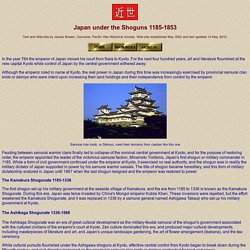
Web-site established May 2002 and last updated 14 May 2010. Japan Under Shoguns by Lilly Hoare-Hewings on Prezi. Shoguns of Japan. The arrival of a Dutch trading vessel, the Liefde, greatly unsettles the Portuguese and Spanish merchants in Japan.
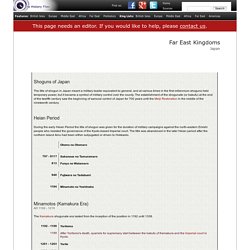
The vessel's pilot, William Adams, is an Englishman of wit and charm. He is escorted to the powerful warlord, Tokugawa Ieyasu, where he reveals the lies peddled by Jesuits about religion in Europe. Ieyasu is no less interested in the Liefde's canon, and it is possible that he uses them in battle later in the year. Tokugawa shogunate. The Tokugawa shogunate, also known as the Tokugawa bakufu (徳川幕府?)
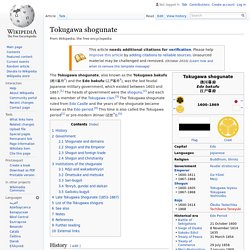
And the Edo bakufu (江戸幕府?) , was the last feudal Japanese military government, which existed between 1603 and 1867.[1] The heads of government were the shoguns,[2] and each was a member of the Tokugawa clan.[3] The Tokugawa shogunate ruled from Edo Castle and the years of the shogunate became known as the Edo period.[4] This time is also called the Tokugawa period[1] or pre-modern (Kinsei (近世?)). [5] History[edit] Following the Sengoku Period of "warring states", the central government had been largely re-established by Oda Nobunaga during the Azuchi-Momoyama period. Japanese history. Japan - Under the Shogun by Melissa Campbell on Prezi. Japan under the Shoguns Assessment Task by Nicholas Ho on Prezi. Japan Under the Shoguns: 1185-1868 book by Mavis Pilbeam. Book Details Seller < See All Copies 1999, Steck-Vaughn Hardcover, Very Good + C$5.71 shipping Details Shipping Options: Standard Shipping: C$5.71 *You will be able to select a shipping option during Checkout.
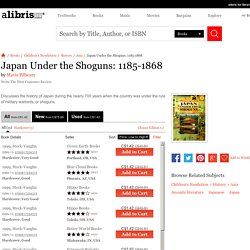
Seller's Description Very good. Hardcover, Good Good. Very good. Good. Good. Hardcover, Fair Fair. Very Good. Good. Japan: Memoirs of a Secret Empire . Program One - Way of the Samurai. In the early 16th century, Japan is a warlike society ruled by samurai and their daimyo warlords.
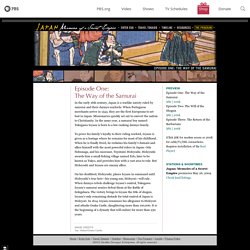
When Portuguese merchants arrive in 1543, they are the first Europeans to set foot in Japan. Missionaries quickly set out to convert the nation to Christianity. In the same year, a samurai boy named Tokugawa Ieyasu is born to a low ranking daimyo family. To prove his family's loyalty to their ruling warlord, Ieyasu is given as a hostage where he remains for most of his childhood. When he is finally freed, he reclaims his family's domain and allies himself with the most powerful rulers in Japan: Oda Nobunaga, and his successor, Toyotomi Hideyoshi. On his deathbed, Hideyoshi, places Ieyasu in command until Hideyoshi's true heir—his young son, Hideyori—will rule. IMAGE CREDITS Top: Hideori/Osaka Castle. Japan: Isolationism & Internationalism. Isolation, Medieval Japanese societal structure, Medieval and early modern societies - Japan, History Year 8, NSW. Introduction When Ieyasu Tokugawa (1526-1549) became shogun in 1603, Japan was trading widely with surrounding countries.

Japan had also made contact with the West, trading with countries as far away as Portugal, the Netherlands, England and Spain. By the early 17th century, however, Japan had forced all foreigners to leave and barred almost all relations with the outside world. Japan's policy of sakoku (isolation) lasted for 200 years, until an American, Commodore Matthew Perry, sailed to Japan and reopened diplomatic relations in 1854.
This chapter discusses the reasons for the policy of isolation held until this time. The Edo Period in Japanese History - Victoria and Albert ... Culture of Japan. Castles in Japan were built to guard important or strategic sites.

Osechi, new year special dishes in three-tiered box The culture of Japan has changed greatly over the millennia, from the country's prehistoric Jōmon period, to its contemporary modern culture, which absorbs influences from Asia, Europe, and North America.[1] Japan's indigenous culture originates primarily from the Yayoi people who settled in Japan between 1000 BCE to 300 CE. Yayoi culture quickly spread to the main island of Honshū, mixing with the native Jōmon culture.[2] Modern Japanese have an estimated 80% Yayoi and 20% Jōmon ancestry.[3] Japan in Isolation by Vanessa L on Prezi. Culture of Japan - history, people, traditions, women, beliefs, food, family, social, marriage. Orientation Identification.
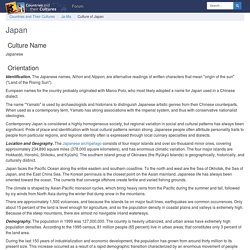
The Japanese names, Nihon and Nippon, are alternative readings of written characters that mean "origin of the sun" ("Land of the Rising Sun"). European names for the country probably originated with Marco Polo, who most likely adopted a name for Japan used in a Chinese dialect. The name "Yamato" is used by archaeologists and historians to distinguish Japanese artistic genres from their Chinese counterparts. When used as a contemporary term, Yamato has strong associations with the imperial system, and thus with conservative nationalist ideologies. Contemporary Japan is considered a highly homogeneous society, but regional variation in social and cultural patterns has always been significant. Location and Geography. Japan%20 %20isolation%20and%20change. Japan Isolation to Adaptation by Shelby DeSmet on Prezi. What prompted Japan's aggression before and during World War II? Courtesy of Library of Congress/Wikimedia Commons This question originally appeared on Quora.

The short version: Japan's actions from 1852 to 1945 were motivated by a deep desire to avoid the fate of 19th-century China and to become a great power. For Japan, World War II grew from a conflict historians call the Second Sino-Japanese War. The Second Sino-Japanese War began in earnest in 1937 with a battle called the Marco Polo Bridge Incident. Japan, From isolation to Adaptation by cheyenne dolen on Prezi. Isolation. Japan’s Strange Isolation, and How It Hurts Us and Japan. Any Western country has close links with the rest of the West.

Take the United States. American culture is fairly similar to Western culture, and there is a deep degree of mixing between the Anglosphere, the United States, and Western Europe. In that sense the market for American companies is not just 300 million people, but rather 800 million people. Japan is different. Japan should have just as close a connection with East and Southeast Asia as the United States has with Western Europe and the Anglosphere. So Japan is left isolated. This is bad for both Japan and the rest of us. This happens, but not enough. Japan: Isolation to Rapid Adaptation by Ty B on Prezi. For how long did Japan's isolation last. Japan's isolation in modern times didn't really begin until Iemitsu Tokugawa's rule in the first half of the 1600s, when he outlawed Christianity, abolished foreign influence, and restricted Western trade with Japan to a Dutch trading company's outpost on a small island of Nagasaki harbor.
Under the Tokugawa shogunate, which lasted until the late 1800s, nothing in Japan changed much: it remained a feudal system with its own unique culture. Then, in 1853, the U.S.'s Admiral Perry barged into Japan with his formidable battle ships and nicely told the Japanese that if they didn't open their country up to other countries, they would have the lovely experience of a U.S. attack (with those scary ships). Japan was also forced into Unequal Treaties. 16 people found this useful Was this answer useful? Japan: Memoirs of a Secret Empire . Timeline - 1600s. Asian Topics on Asia for Educators. Robert Oxnam :: The third dimension of the Tokugawa obsession with order, in addition to politics and society, was in international relations.
They sought a new approach by closing Japanese borders to Western nations and by seeking a reordering of relations with other East Asian countries. Carol Gluck :: Isolation, closing off the country, not closed off to Asia, but closed off to the West because the West was an unsettling, disordering possibility, whether it was in the form of Christianity or it was in the form of colonization. Henry D. Smith, II :: The early Tokugawa shoguns did not feel in any way that they were imposing particularly unique restrictions or closing the country.
Rather, they were trying to regulate trade to their own advantage and to reorder international relations along the lines of the international system that they'd always known, which was that of the "East Asian Cultural Sphere," as it's called. Henry D. Chofield Museum of History, Japan Isolation to Adaptation ... Why did Japan end its self-chosen isolation in the 19th century and open up to the modernising influence of Western states? - Quora. China and Japan's Isolationism by kassidee matthews on Prezi. Why did Japan go into isolation? by rawan madi on Prezi. How did isolation affect Japan? by darby sherard on Prezi. What Caused Japan's Policy of Isolation? What Caused Japan's Policy of Isolation?